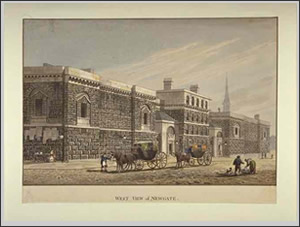Properly speaking, Samuel Uriah Stotter did not belong to my family at all, but I became involved when doing a little research for my cousin. It is the story of a white collar crime which took place in 1847 and involved embezzlement, detection, a police line-up and a number of reports in The Times newspaper.
Samuel was born in Surrey about 1809 and married Elizabeth Ann Dexter on 4th June 1829 at St Mary Newington. In 1841, the family were living in the Apollo Buildings, St Mary Newington, with six young children and with Samuel making his living as a shoemaker. At some point between 1841 and 1847, Samuel had become an employee of the postal service, becoming a letter carrier and sorter for the Newington district, a position of trust and some responsibility.
Perhaps the expense of maintaining his large family drove him to crime, or perhaps it was simply a case of opportunity and cupidity. Whichever the case, he devised an elaborate scheme involving robbery and forgery, which came unstuck due to a lack of nerve at the critical point.

As subsequently reported in The Times on 22nd July 1847, a Mr James, a solicitor of Ely Place, Holborn, had sent a letter to a Mrs Hedlow in Scotland, enclosing a cheque drawn on Masterman’s Banking House for £55. Samuel intercepted this letter and the following day sent a forged cheque to Messrs Masterman, requesting that the amount might be forwarded to ‘Mrs Hedlow, Spring Cottage, Kensington’, in full knowledge that no such address existed. The bankers sent halves of the notes, as requested and upon receiving a letter (from Samuel) acknowledging receipt, subsequently sent the other half.
It was usual with the Post Office to give such wrongly addressed Kensington letters to the Kennington postman to be taken around his district to check on errors of superscription. Samuel was one of those who superintended the Kennington delivery, so was ideally placed to retrieve the letters from the delivery.
Notes from Masterman’s Banking House were presented to the Bank of England on the 28th July, by John Walker, a lad of about fourteen or fifteen years old, with a written request to exchange them for gold sovereigns. The bank cashier was suspicious, detained the lad and made enquiries of Messrs Masterman, discovering the existence of the forgery. Upon being questioned, John Walker stated that a gentleman had approached him in North Street, Westminster and had promised him 2s if he would go to the bank with a letter to get him some money and bring it to him at the Coach and Horses public house in North Street. John Walker was instructed to tell the gentleman that he must call in person at the bank to receive his money. He did so, got his promised 2s, and went home. Needless to say, nobody called at the bank to collect the sovereigns.
As soon as the Post Office became aware of the problem, they began an investigation and soon discovered the theft and forgery, but did not suspect Samuel, as he was held in a high degree of trust.
However, the wheels had been set in motion and further detection led to Samuel’s downfall.
The failure of his attempt to gain the 55 sovereigns did not deter Samuel from making further attempts. An attempt to gain £25 from the bankers, Messrs Hanbury, by requesting that bank notes be sent to a Mr Edward Gibbs of Princes Square, London, served to direct attention towards Samuel, as the only Princes Square was in Kennington. A letter from Messrs Hanbury to Mr Gibbs, telling him that the money could not be made available until Monday was not recorded at the Post Office, although both address and name were incorrect. A second, similar letter was dispatched, both being subsequently found in Samuel‘s possession.
Once the Post Office had a suspect, they arranged a ‘line up’ of six persons, at which the witness, John Walker, of 11 Wood St Westminster, identified the gentleman who had employed him to approach the Bank of England.
Samuel was arrested, arraigned before a magistrate and remanded in Newgate Prison until his trial in the Central Criminal Court, where he was sentenced on 6th January 1848 to ten years transportation. He was conveyed to the Swan River Colony on board ‘The Pyrenees’, as convict no. 483, leaving Torbay on 30th March 1851 and arriving in Fremantle on 28th June 1851. Six months later, he was granted a ticket of leave. He was described as being “5’6” tall, with grey hair, dark eyes, a round face, a dark complexion and very hairy on the breast”.
His wife Elizabeth remained in St Peter Newington, and at the time of the 1851 census, was living with four of her children, supporting herself with needlework and describing herself as a ‘widow’. Some years later, Elizabeth, accompanied by several of her children, followed her husband and is thought to have arrived in Fremantle on board ‘The Lochnagar’ on 11th February 1858. Notes on Samuel’s file mention that he was working on his own behalf in 1857, and he gained ‘expiree’ status in 1861.
Samuel and his family had only ten years together in the new land, with Samuel dying in 1868 and Elizabeth living until 1884. The children who emigrated with Elizabeth overcame the stigma of their father’s crime and sentence, prospered in the new country, acquired property, intermarried with the free emigrant population and established their families in and around Fremantle.
Macbev
© Macbev 2008
